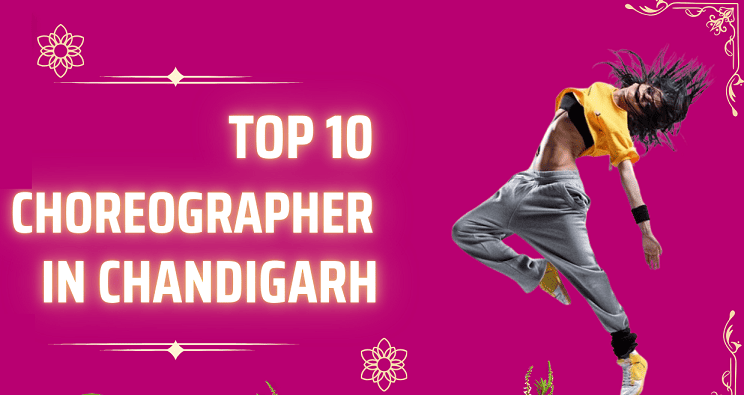Top 10 Choreographers in Chandigarh
Choreographers in Chandigarh – Choreographers are the creative minds behind the design and arrangement of dance movements, routines, and performances. They play a significant role in transforming music or themes into visually captivating and expressive dance performances.
Whether for stage productions, music videos, dance competitions, or fitness routines, choreographers bring energy, rhythm, and storytelling to life through movement.
Types of Choreographers
Stage Choreographers: These choreographers work on theatrical performances, such as musicals, ballet, and dance shows. They design the dance sequences that are performed live on stage.
Film and Television Choreographers: Specializing in choreographing dance for movies, television shows, and music videos, these professionals work closely with directors, producers, and performers to create dance sequences that fit the story line and vision.
Dance Competition Choreographers: Often working with dance teams or individuals, these choreographers design routines for competitive dance events. Their work focuses on precision, creativity, and performance to win judges’ approval.
Fitness Choreographers: These choreographers create dance-based fitness routines, such as Zumba, aerobics, or hip-hop fitness. They combine dance movements with exercise to keep people engaged while improving their fitness.
Freelance Choreographers: Many choreographers operate on a freelance basis, offering services to dance studios, theater companies, film productions, and events. They might specialize in specific dance styles or be versatile in creating choreography for multiple genres.
Wedding & Event Choreographers: These choreographers work with couples or event organizers to create memorable dance performances, often for first dances at weddings or performances at corporate events and celebrations.
Services Offered by Choreographers
Dance Routine Creation: Choreographers design original dance routines for various purposes, including stage performances, competitions, parties, or special events.
Dance Instruction: Many choreographers also teach dance, breaking down complex routines into manageable steps for students or performers to learn. This could be for group classes or private lessons.
Creative Direction: Choreographers often provide overall creative direction for performances, collaborating with other artistic professionals like directors, set designers, and musicians to create a cohesive performance.
Performance Preparation: Choreographers also help performers prepare for shows or competitions by guiding them through rehearsals, offering feedback on their technique, and ensuring the performance flows seamlessly.
Specialized Dance for Events: For weddings, parties, and corporate events, choreographers craft personalized performances for the hosts, such as a first dance for a bride and groom, or a flash mob for a special celebration.
Popular Dance Styles Choreographers Work With
Classical Ballet: A highly structured style of dance that requires discipline and intricate movements. Ballet choreographers work with dancers to create elaborate routines, often involving storytelling through movement.
Contemporary Dance: This modern dance style blends elements of ballet, jazz, and modern dance. Contemporary choreographers create innovative routines that express emotion and abstract themes.
Hip-Hop and Street Dance: These styles focus on energetic, rhythmic movements performed to hip-hop, rap, or pop music. Hip-hop choreographers often work with urban dance crews and create routines for music videos or competitions.
Jazz and Tap Dance: These dance styles are known for their upbeat tempos and rhythmic footwork. Jazz choreographers often create routines for stage performances, while tap choreographers focus on intricate foot patterns.
Latin and Ballroom Dance: Choreographers working with styles such as salsa, tango, and waltz design intricate footwork and synchronized partner movements for competitions and performances.
Bollywood and Indian Classical Dance: These choreographers design vibrant dance routines for Bollywood films or stage productions, often blending traditional Indian classical dance with modern influences.
Folk Dance: Choreographers working with regional or cultural dance forms like bhangra, garba, or Kathak incorporate traditional movements and cultural elements into their choreography.
Skills Required to be a Choreographer
Creativity: A choreographer must have a keen sense of creativity to envision movements and translate them into choreography.
Strong Dance Background: A deep understanding of various dance forms and techniques is essential.
Musicality: Choreographers must have a strong sense of rhythm and timing to ensure that the dance movements align with the music.
Leadership and Communication: Choreographers lead dancers during rehearsals, so they must be able to communicate their vision clearly and motivate performers.
Attention to Detail: Every movement and position matters. A choreographer’s eye for detail ensures the performance is polished and visually captivating.
Adaptability: The ability to adapt choreography for different settings, performers, and styles is crucial.
How to Choose a Choreographer
Experience: Look for choreographers with relevant experience in the dance style you are interested in.
Portfolio: Check their past work or performance videos to gauge their creativity and style.
Reputation: Read reviews or ask for recommendations from others who have worked with the choreographer.
Personality and Teaching Style: A choreographer’s approach to teaching and guiding performers is important, especially if you are working with beginners or children.
Budget: Make sure the choreographer’s fees align with your budget, keeping in mind that rates may vary based on experience and event type.
Choreographers are essential for bringing dance performances to life, whether on stage, in films, or at special events.
Their ability to craft memorable routines that blend artistic expression, technique, and creativity makes them highly sought after in the world of entertainment and event planning.
Whether for a wedding, competition, or theater production, hiring the right choreographer ensures that your dance performance is flawless, engaging, and impactful.
FAQ
How does a choreographer work?
Choreographers design and direct dance and stylized movement for productions, collaborating closely with directors and musicians. They work with dancers to develop ideas and transform them into polished performances.
The process involves interpreting themes, creating sequences, and refining movements. Choreographers blend artistic vision with technical expertise, considering music, staging, and performers’ abilities. They guide rehearsals, make adjustments, and ensure the final product aligns with the overall production concept.
Are there any special requirements for choreographers?
While formal qualifications aren’t mandatory, many choreographers begin as dancers and often study dance at college or university. A strong background in various dance styles, creativity, and leadership skills are essential.
Experience in performance, teaching, or directing is valuable. Understanding music, theatrical elements, and body mechanics is crucial. Continuous learning, networking, and updating industry trends are essential for success in this competitive field.
What are choreographers expected to do?
Choreographers create and design dance routines and movements for performers to execute, typically set to music. They conceptualize ideas, develop step sequences, and craft overall dance compositions. Choreographers work on various projects, from stage productions to music videos.
They collaborate with directors, teach routines to dancers, oversee rehearsals, and make necessary adjustments. Their role includes selecting dancers, coordinating with costume and set designers, and ensuring the choreography enhances the production.
How many hours do choreographers work?
Choreographers’ work hours vary significantly based on project demands. During intense periods, such as approaching opening nights or tour launches, they might work up to 14 hours a day. Other times, workdays could be shorter.
The schedule is highly flexible and project-dependent. Long rehearsals, last-minute changes, and perfecting performances often require extended hours. Balancing multiple projects can lead to irregular schedules, making time management crucial in this career.
What is the principle of a Choreographer?
The five core principles of choreography are dynamics, space, relationships, actions, and body parts. These elements form the foundation of dance creation and work together to produce effective choreography.
Dynamics involve the quality of movement, while space considers the use of the performance area. Relationships refer to interactions between dancers; actions encompass the specific movements performed and body parts focus on how different body areas are utilized in the dance.
What is the career objective of a choreographer?
A choreographer’s primary goal is creating fresh, engaging dance routines entertaining and moving audiences. They aim to work across various settings, from private clients to large-scale performances.
Career objectives may include choreographing for renowned dance companies, Broadway shows, or famous music artists. Many seek to push creative boundaries, develop unique styles, and make significant artistic contributions to the dance world. Some aspire to open their dance studios or companies.
Is choreography a profession?
Choreography is indeed a legitimate profession with diverse employment opportunities. Choreographers work in various entertainment sectors, including dance productions, musicals, commercials, music videos, television, and film.
Some specialize in particular dance styles like ballet, modern dance, hip-hop, jazz, or musical theatre. The profession requires artistic vision, technical skills, and business acumen. Successful choreographers often build reputations that lead to steady work and career advancement.
Is choreography a talent?
Choreography is both a talent and a skill that can be developed. The ability to visualize and create compelling dance combinations is a valuable asset. While some individuals may have a natural aptitude for choreography, it can also be honed through practice, study, and experience.
Exceptional choreographers often combine innate creativity with technical proficiency and a deep understanding of movement. Coupled with solid dance abilities, the talent for choreography can lead to outstanding career opportunities.
How do choreographers record their work?
Choreographers use various methods, with dance notation being a formal written system. Unlike music notation, there isn’t one universally accepted system. Prominent dance notation systems include Labanotation and Benesh Movement Notation.
Many modern choreographers also use video recording, detailed written descriptions, or digital software to document their creations. Some develop personal shorthand systems. Accurate recording is crucial for preserving choreography and facilitating its reproduction by other dancers or companies.
Do choreographers have to be dancers?
While many choreographers start as dancers, it’s not an absolute requirement. However, a strong dance background is highly beneficial. Choreographers often discover their passion for design while dancing professionally.
They frequently work on a contract basis and may continue performing to supplement their income. Some choreographers transition into roles like dance captains for the shows they design. A deep understanding of dance technique, gained through personal experience, dramatically enhances a choreographer’s ability to create and communicate movement effectively.
Thanks for visiting – Chandigarh News



